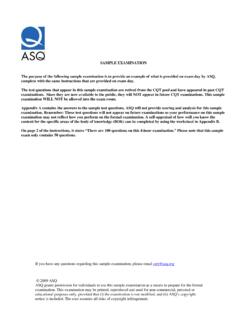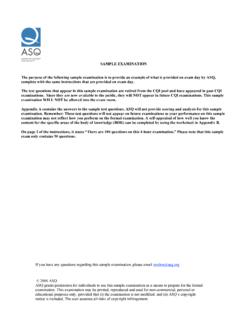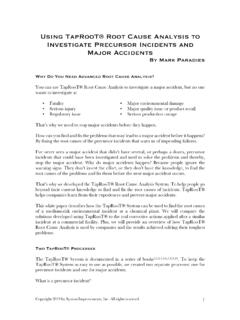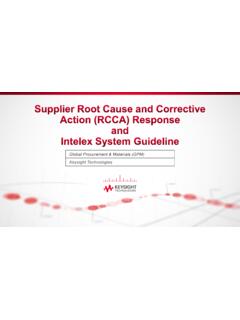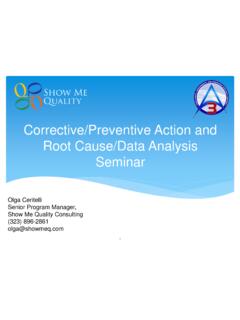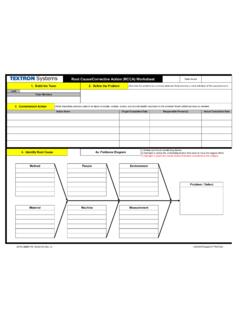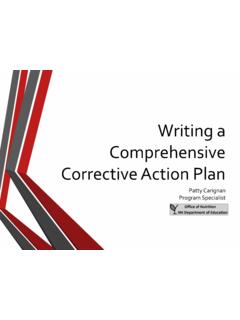Transcription of CORRECTIVE ACTION RESPONSES Just Tell Me What You …
1 Submit your response after you have completed all the ProblemDoes the problem description identify: - What is wrong with what? - Where the problem was first seen? - When was the problem first seen?Have you considered what the problem is not?Have you investigated whether the problem has been seen before or since this problem was first reported?Interim ActionsHave all potention locations of defective product been included in the containment plan? (production floor, inventory, distribution center, in-transit, customer locations)Does the containment plan protect the customer against further escapes until a permanent CORRECTIVE ACTION can be implemented?Does the customer need to be contacted? root Cause AnalysisHave you identified the most relevant potential cause(s)? - was man, machine, method, materials and environment considered? - was relevant data gathered in determining cause(s)?Have you asked 'WHY' 5 times of the identified cause to determine the root cause?
2 Can you turn the problem on and off by introducing and removing the suspected root cause?Does the root cause explain all we know about the problem description as described in Step 1 (what/where/when)? Permanent ActionsHas a plan been developed that includes specific milestones and people responsible for implementation?Have error proofing techniques, preventive measures and/or visual aids been considered?VerificationHave you developed methods to verify that the CORRECTIVE ACTION eliminates the root cause over at least a 3 month period (audits, measurement)?Is there evidence that the permanent CORRECTIVE ACTION totally eliminates the defect associated with the root cause?ControlHave you considered instituting measures or inspections such that the problem does not repeat?Have the changes associated with the CORRECTIVE ACTION been documented in work instructions, specifications, drawings and/or procedures to institute this change?Have all appropriate personnel been notified and trained on the change?
3 Has a reaction plan been established if problem should reoccur to contain problem?Are the controls in place to assure the CORRECTIVE ACTION does not produce undesirable results?PreventionHas the new change become part of the training for new hires?Has the change become part of preventive maintenance?Have you investigated whether similar nonconformances could be produced in other products, operational processes or locations?Have changes been made that will prevent similar nonconformances from occurring?Note: "Told the operator to be more careful does not satisfy ACTION Response ChecklistCORRECTIVE ACTION RESPONSES Just Tell Me What You Want Me to Put Down?By Robin Dudash, CQManager, CQA, CQE, CRE, CSQE, QS-LA One of the keys to continuous improvement is permanent CORRECTIVE ACTION . I have seen various levels of CORRECTIVE ACTION RESPONSES , but very few that follow through and permanently resolve the problem. Hence, the organization continues to operate in fire-fighting mode chasing a problem that returns again and again.
4 There are several reasons why these problems reoccur. Most of them I am sure you know already: 1) allowing interim actions to fix the root cause, 2) more than one root cause, 3) verification that the ACTION was taken, or 4) controls in place to prevent them from happening again. In responding to CORRECTIVE ACTION requests, there are two options with their own consequences. The Quality Manager can try to respond to the CORRECTIVE actions, but discover that not all of the information is available, or has the authority to make the needed changes. The next second option is assigning the CORRECTIVE ACTION to the persons responsible for the solution. Of course, we all know that these people blame the operator for the problem and that problem is considered closed. The next logical step is to conduct a CORRECTIVE ACTION Training Class.
5 Everybody in the organization attends the root Cause Analysis Training and then they will be able to resolve CORRECTIVE actions. The class even runs through some actual examples. Everyone appears to understand until the first CORRECTIVE ACTION response is read by the Quality Manager after the class. It is only slightly better than before the class. Verdict: What you don t use, You lose. This is why I developed a CORRECTIVE ACTION Response Checklist. A tool to be used after the root Cause Analysis Class , so that by answering the questions an appropriate response can be f ormulated. Define the Problem Take time to adequately define the problem (who, what, when, why, where, how much and how often). Sometimes it is also easier to define the problem by clarifying what it is not. Interim Actions Once a problem as been detected, the first priority should be to contain the problem, and prevent shipment to the customer.
6 If already shipped, the customer needs to be notified to prevent further liability. root Cause Analysis The key to resolving a problem is identifying the true root cause or cause(s). Don t be afraid to ask the basic WHY? 5 times. Of course, everyone knows it was the operator s fault. My favorite answer during this interview is, I didn t know. There may be several underlying causes for this answer: a new operator, a change in procedure, or another rush job circumventing the system. This is why it is important to find the root cause of the issue and define a permanent solution. Permanent Actions The process should be reviewed to arrive at a solution for correcting the root cause. This review should engage the 7 basic quality tools. The solution may involve longer term planning, requiring milestone dates, capital justification, training, and/or approval from the customer.
7 It is good to review progress in management review to assure accountability after the Interim Actions have stopped the bleeding . Verification Perhaps in their haste to close the ACTION , or willingness to trust the word of colleagues, most organizations find closure in just having taken the CORRECTIVE ACTION . Checkpoints in the process should be created to verify effectiveness. This could be accomplished by inspection, dock audits, internal audits, and/or measurement. It has been my experience that verification should take a period of at least 3 months, because sometimes it takes longer to incorporate procedural changes that involve people (which all organizations have!). Control If mistake proofing was not part of the solution then a measurement to detect the root cause early should become part of the system. A procedural change should become part of the system by updating the work instruction and training for accountability.
8 Consider putting a reaction plan in place should the problem reoccur. Prevention Very few organizations reach this step. For example, all the above steps are completed, yet the problem returns 6 months later. Perhaps, a new operator shows up who may have been qualified through On-the-Job training without verification of their competency. Or the filter was replaced as part of the solution, but it is dirty again and hasn t been placed on the Preventive Maintenance schedule. Conclusion With organizations reduced, they cannot afford to subsidize fire-fighting . It is anticipated that this CORRECTIVE ACTION Response Checklist will assist organizations in making the permanent ACTION part of the system for effective closure. This one s for everyone who ever asked me Just tell me what you want me to put down! Ms. Robin Dudash currently owns her own company that conducts consulting for ISO-9001 and sector-specific quality system development, training services, and internal quality auditing services.
9 She is also a subcontract Lead Assessor for a Registrar. Ms Dudash has degrees in Computer Science and Applied Mathematics, and a Masters in Business Administration (MBA), concentrating in finance, from the University of Pittsburgh. She may be contacted at

